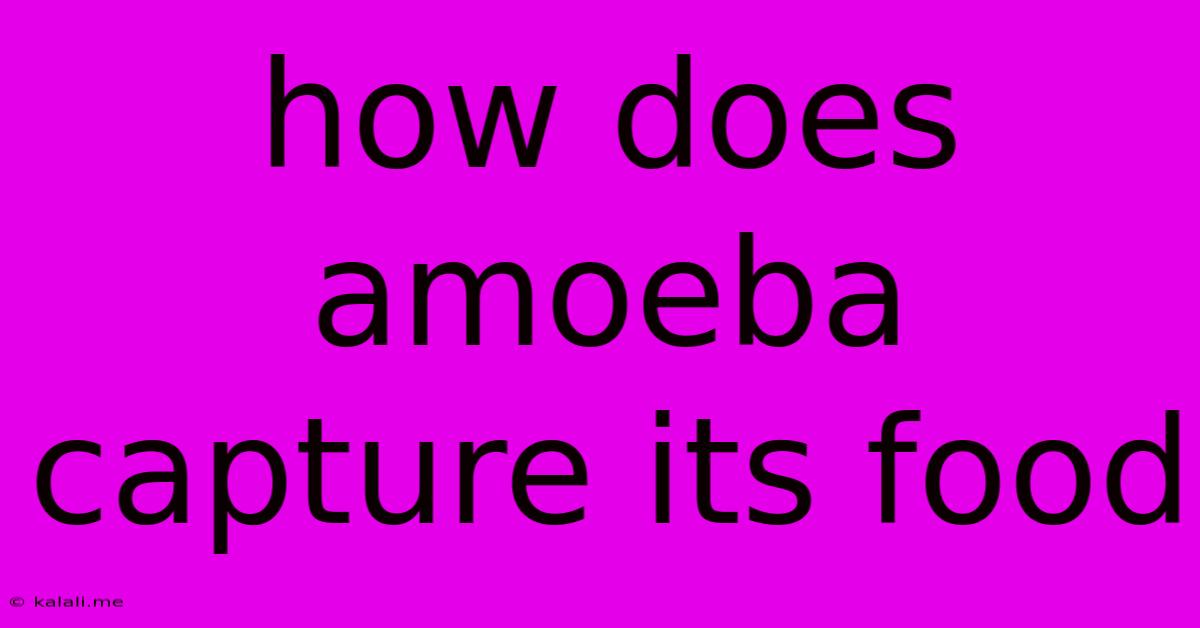How Does Amoeba Capture Its Food
Kalali
Jun 14, 2025 · 3 min read

Table of Contents
How Does an Amoeba Capture Its Food? A Deep Dive into Phagocytosis
Amoebas, single-celled organisms found in various aquatic environments, are fascinating examples of how life can thrive at a microscopic level. One of the most captivating aspects of their biology is their unique method of feeding: phagocytosis. This article will explore the intricate process by which amoebas capture and consume their food, delving into the cellular mechanisms and adaptations that make this possible. Understanding amoeba feeding offers a glimpse into the fundamental principles of cellular nutrition and the evolutionary adaptations of simple organisms.
Understanding Phagocytosis: The Amoeba's Feeding Mechanism
Phagocytosis, meaning "cell eating," is the process by which a cell engulfs solid particles, including bacteria, algae, and other smaller protists. For amoebas, this is their primary method of obtaining nutrients. It's a crucial process that underpins their survival and highlights the remarkable adaptability of these single-celled organisms. The process involves several key steps:
-
Chemotaxis: Amoebas don't just randomly bump into their food. They actively detect the presence of potential food sources through chemotaxis – movement towards a chemical stimulus. Nutrients or waste products released by the prey attract the amoeba, guiding it towards its meal. This ensures efficient foraging and increases the likelihood of successful prey capture.
-
Recognition and Attachment: Once an amoeba encounters potential food, it needs to recognize it as edible. Specific receptors on the amoeba's cell membrane bind to molecules on the prey's surface. This recognition step is vital; it prevents the amoeba from engulfing non-nutritive particles.
-
Pseudopod Extension: Amoebas are known for their flexible cell membranes and their ability to form pseudopods ("false feet"). Upon recognizing food, the amoeba extends pseudopods around the prey particle. These temporary projections of the cytoplasm are crucial for engulfing the food. The process is often described as the amoeba "flowing" around the prey.
-
Phagosome Formation: As the pseudopods encircle the food particle, their membranes fuse, enclosing the prey within a membrane-bound vesicle called a phagosome. This sealed compartment isolates the food from the amoeba's cytoplasm, preventing damage to the amoeba's internal structures.
-
Digestion: Once the phagosome is formed, it fuses with lysosomes, organelles containing digestive enzymes. These enzymes break down the ingested food into smaller, usable molecules. This process of intracellular digestion releases nutrients that are then absorbed by the amoeba's cytoplasm, providing energy and building blocks for growth and repair.
-
Waste Excretion: After digestion, the indigestible waste materials are expelled from the amoeba through exocytosis – the reverse process of phagocytosis. The waste is enclosed within a vesicle that fuses with the cell membrane, releasing the contents to the outside.
Adaptations for Efficient Food Capture
The efficiency of amoeba feeding relies on several key adaptations:
-
Flexible Cell Membrane: The fluidity of the amoeba's cell membrane is crucial for the formation of pseudopods. This allows for dynamic changes in cell shape, enabling it to effectively surround and engulf prey of varying sizes.
-
Cytoplasmic Streaming: Cytoplasmic streaming, the movement of cytoplasm within the amoeba, plays a vital role in extending pseudopods and transporting digested nutrients. This coordinated movement of cytoplasm facilitates both prey capture and intracellular transport.
-
Receptor Proteins: The presence of specific receptor proteins on the cell membrane allows the amoeba to distinguish between edible and non-edible particles. This precise recognition prevents the engulfment of harmful or non-nutritive substances.
Conclusion: A Microscopic Master of Phagocytosis
The amoeba's method of capturing food through phagocytosis is a remarkable display of cellular ingenuity. This process, involving chemotaxis, pseudopod extension, phagosome formation, digestion, and waste excretion, is a testament to the remarkable adaptations that allow single-celled organisms to thrive in diverse environments. Understanding this intricate process provides a valuable insight into the fundamental mechanisms of cell biology and the evolutionary strategies employed by simple life forms to secure their survival.
Latest Posts
Latest Posts
-
Electric Current Is Defined As The Flow Of
Jun 14, 2025
-
Which Of The Following Is A Primary Pollutant
Jun 14, 2025
-
Difference Between A Physical Map And A Political Map
Jun 14, 2025
-
Definition Of Normal Profit In Economics
Jun 14, 2025
-
Is 23 A Multiple Of 3
Jun 14, 2025
Related Post
Thank you for visiting our website which covers about How Does Amoeba Capture Its Food . We hope the information provided has been useful to you. Feel free to contact us if you have any questions or need further assistance. See you next time and don't miss to bookmark.